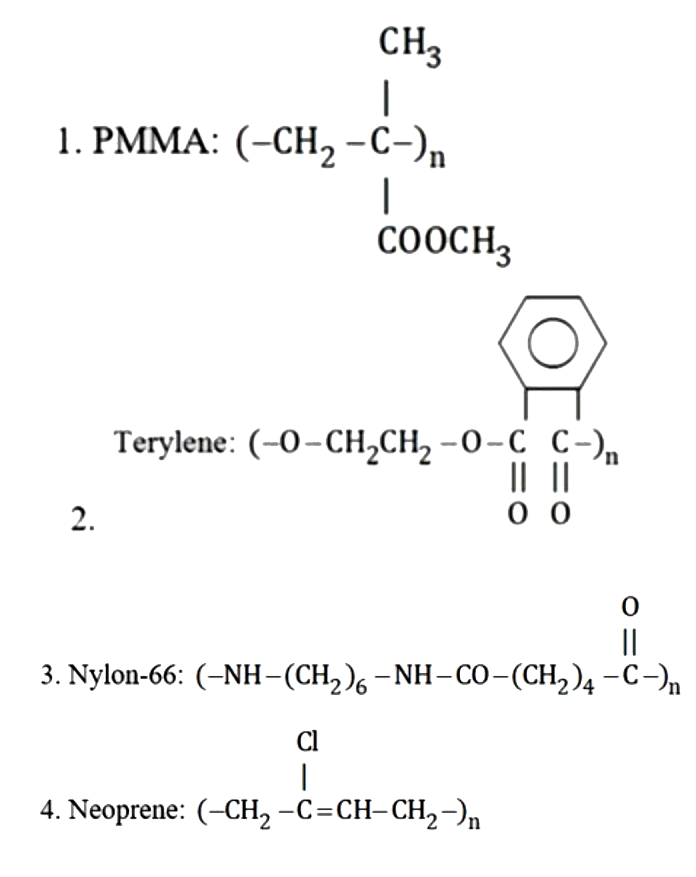[−NH(CH2)6NHCO(CH2)4CO−]n is a
Thermosetting polymer
Homopolymer
Copolymer
Addition polymer
The correct Answer is:C
To determine the identity of the polymer represented by the formula (−NH(CH2)6NHCO(CH2)4CO−)n, we can follow these steps:
Step 1: Analyze the Structure
The given structure can be broken down into its components. The repeating unit contains:
- An amine group (-NH-)
- A hexamethylene chain (6 carbon atoms)
- An amide linkage (NHCO)
- A butanedioic acid (4 carbon atoms)
Step 2: Identify the Monomers
From the structure, we can identify the two monomers involved in the formation of this polymer:
1. Hexamethylene diamine: This is a compound with the formula H2N(CH2)6NH2, which contains two amine groups and a six-carbon chain.
2. Adipic acid: This is a dicarboxylic acid with the formula HOOC(CH2)4COOH, which contains a four-carbon chain and two carboxylic acid groups.
Step 3: Understand the Polymerization Process
The polymerization occurs through a condensation reaction where:
- The amine groups from hexamethylene diamine react with the carboxylic acid groups from adipic acid.
- This reaction releases water (H2O) and forms amide bonds (-NHCO-).
Step 4: Determine the Type of Polymer
Since the polymer is formed from two different types of monomers (hexamethylene diamine and adipic acid), it is classified as a copolymer.
Step 5: Name the Polymer
The polymer formed from these two monomers is known as Nylon 6,6. The name comes from the fact that both monomers contribute 6 carbon atoms each to the polymer chain.
Conclusion
The polymer represented by the formula (−NH(CH2)6NHCO(CH2)4CO−)n is Nylon 6,6.
---
The given structure can be broken down into its components. The repeating unit contains:
- An amine group (-NH-)
- A hexamethylene chain (6 carbon atoms)
- An amide linkage (NHCO)
- A butanedioic acid (4 carbon atoms)
From the structure, we can identify the two monomers involved in the formation of this polymer:
1. Hexamethylene diamine: This is a compound with the formula H2N(CH2)6NH2, which contains two amine groups and a six-carbon chain.
2. Adipic acid: This is a dicarboxylic acid with the formula HOOC(CH2)4COOH, which contains a four-carbon chain and two carboxylic acid groups.
The polymerization occurs through a condensation reaction where:
- The amine groups from hexamethylene diamine react with the carboxylic acid groups from adipic acid.
- This reaction releases water (H2O) and forms amide bonds (-NHCO-).
Since the polymer is formed from two different types of monomers (hexamethylene diamine and adipic acid), it is classified as a copolymer.
The polymer formed from these two monomers is known as Nylon 6,6. The name comes from the fact that both monomers contribute 6 carbon atoms each to the polymer chain.
The polymer represented by the formula (−NH(CH2)6NHCO(CH2)4CO−)n is Nylon 6,6.
Topper's Solved these Questions
- BOOK - PHYSICS WALLAHCHAPTER - POLYMERSEXERCISE - NEET Past 5 Years Questions7videos
POLYMERS
- BOOK - PHYSICS WALLAHCHAPTER - POLYMERSEXERCISE - NEET Past 5 Years Questions7videos
POLYMERS
- BOOK - PHYSICS WALLAHCHAPTER - ORGANIC CHEMISTRY EXERCISE - NEET PAST 5 YEARS QUESTIONS13videos
ORGANIC CHEMISTRY
- BOOK - PHYSICS WALLAHCHAPTER - REDOX REACTIONSEXERCISE - LEVEL-140videos
REDOX REACTIONS
Similar Questions
Write the names of monomers of the following polymers :
−[−NH−(CH2)6−NH−CO−(CH2)4−CO−]−nView Solution(i) What is the role of t-butyl peroxide in the polymerization of ethene?
(ii) Identify the monomers in the following polymer:
−(NH−(CH2)6−NH−CO−(CH2)4−CO)−n
(iii) Arrange the following polymers in the increasing order of their intermolecular forces :
Polystyrene, Terylene, Buna-SView Solution
Knowledge Check
- Question 1 - Select One
~[NH(CH2)NHCO(CH2)4CO]~ is a
AhomopolymerBcopolymerCaddition polymerDthermoseting polymer - Question 2 - Select One
[NH(CH2)6NHCO(CH2)4CO]n is a
Aaddition polymerBthermosetting polymerChomopolymerDcopolymer - Question 3 - Select One
Which of the following polymers are correctly matched ?

2. Nylon - 66 : ⎛⎜ ⎜⎝−NH−(CH2)6−NH−CO−(CH2)4−O∣∣C−⎞⎟ ⎟⎠n
4. N e oprene : ⎛⎜ ⎜⎝−CH2−Cl∣C=CH−CH2−⎞⎟ ⎟⎠nA1, 2B3, 4C1, 3, 4D1, 2, 3, 4
How many of the following compounds cleave diborane symmetrically?
CH3NH2,(CH3)2NH,(CH3)3N,CO(CH3)2O,NH3View Solution2(CH3)2CO+NH3→
View SolutionWhat reagents could you use for te following conversions.
(a). MeCO(CH2)2CO2EoMeCHOH(CH2)2CO2Et
(b). HO2C(CH2)4COCl→HO2C−(CH2)4CH2OH
(c). O2N(CH2)2CN→O2N(CH2)2CH2NH2
(d). O2N(CH2)2CH=CH2→H2N(CH2)2CH=CH2
(e). Me2CHCOC<oMe2CHCHO
(f). O2N(CH2)3CHO→O2N(CH2)3CH2OH
(g). O2N(CH2)2CH=CH2→O2N(CH2)3CH3View SolutionWrite IUPAC names of the following :
(i) CH3CH2C∣CH3HNH2 (ii) (CH3)3CNH2 (iii) C6H5(CH2)3NH2
(iv) NH2(CH2)4C∣NH2HCOOH (v) C6H5–CH3∣CHCH2NH2 (vi) H3C−N∣H−CH2−CH3View SolutionWirte IUPAC names of the following compounds and classity them into primary , secondary and tertiary amines .
i. (CH3)2CHNH2 ii. CH3(CH2)2NH2
iii. CH2NHCH(CH3)2 iv. (CH3)3CNH2
v. C6H5NHCH3 vi. (CH3CH2)2NCH3
vii. m−BrC6H4NH2View Solution

